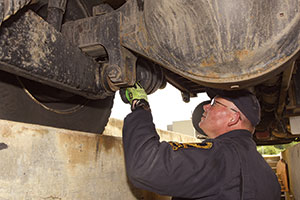Senior Reporter
Lower Percentage of Trucks Out of Service Due to Brake Problems During Safety Event

The out-of-service rate during Brake Safety Week in September was 12.3%, a decline from 16.2% last year, the Commercial Vehicle Safety Alliance reported.
There were 2,321 vehicles placed out of service for brake violations, CVSA said.
It announced the findings Oct. 29, noting that 18,817 commercial
vehicles were inspected in the United States and Canada during Sept. 6-12. That compares with 13,305 inspections a year ago.
William Schaefer, CVSA’s director of vehicle programs, said the lower numbers should be viewed with caution, however.
“They vary from year to year,” Schaefer told Transport Topics. “It will be an interesting trend if over the next three or four years the rates continue to fall. But I can’t conclude that they are falling.”
Local, state, provincial, territorial and federal motor carrier safety officials in both nations conducted the roadside inspections throughout the campaign.
Trucks and buses generally were chosen at random for the Level IV brake inspections, Schaefer said.
The purpose of the enforcement was to identify flaws including brake-system components with loose or missing parts, air or hydraulic fluid leaks and cracked, damaged or worn linings, pads, drums and rotors.
Inspectors also checked anti-lock braking-system malfunction indicator lamps, brake components and measured pushrod stroke, where applicable, according to CVSA.
“For everyone’s safety, it’s vital that every vehicle operating on our highways and roads is mechanically sound and properly maintained,” FMCSA acting Administrator Scott Darling said in a statement.
Added Maj. Jay Thompson of the Arkansas Highway Police and CVSA president: “Improperly installed or poorly maintained brake systems can reduce braking capacity and increase stopping distance of large trucks and buses, which poses serious risks to driver and public safety.”
The out-of-service rate for brake adjustment also was lower this year at 7.7%, compared with 10.4% in 2014. It was 6.9% for brake components, down from 9.3% in 2014.
Overall out-of-service rates for brake violations in Canada — historically lower than the United States — were 9%. That compared with 12.7% in the United States.
Brake component violations were 6.9% in the United States and 6.2% in Canada. But brake adjustment violation rates were 8.2% in the United States and 3.7% in Canada.
The states with the highest percentage of brake out-of-service rates were South Carolina (32.2%), Colorado (23.4%) and Arizona (21.1%). The states with the lowest rates were Rhode Island (5.3%), Kansas (5.6%) and Texas (5.7%).
British Columbia was the Canadian province with the highest out-of-service rate at 16.6%. New Brunswick registered at 0%.
Brake system and brake adjustment violations consistently represent nearly half of the out-of-service violations annually, Schaefer said.
In fact, the Federal Motor Carrier Safety Administration’s 2006 large-truck crash causation study concluded that the most common vehicle-associated factor in crashes was brake problems, Schaefer noted.
Brake Safety Week is part of the Operation Airbrake Program sponsored by CVSA in partnership with FMCSA and the Canadian Council of Motor Transport Administrators.
The program, first developed in 1998 in Canada, has grown to include two annual enforcement events, as well as educational activities across North America throughout the year. More than 3.8 million brakes have been inspected since the program’s inception.




